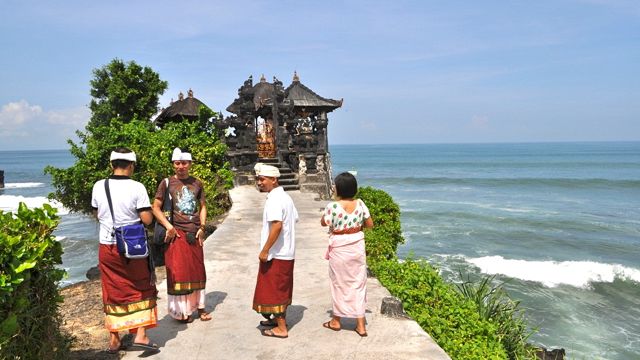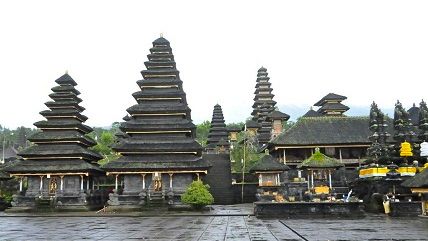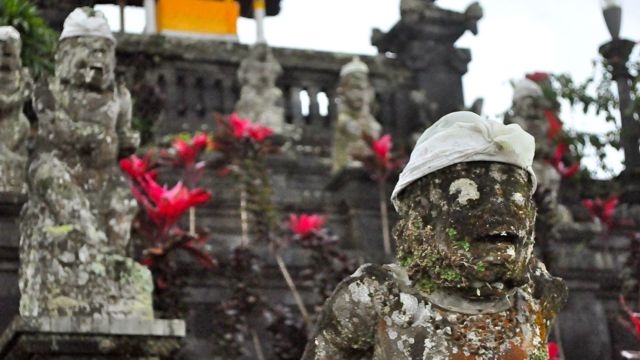SUMMARY
This is AI generated summarization, which may have errors. For context, always refer to the full article.

MANILA, Philippines – Whenever I walk to one of Bali’s large temples, I cannot help but feel that I am looking at nature’s work of art instead of an architectural masterpiece.
Take Tanah Lot, for example. The temple, among trees and vegetation, rests on a rock island off the beach, giving the effect of a giant bonsai. The actual structures of roofs with no walls and the pagoda-like towers called meru look simple yet striking, their dark colors blending perfectly with the gray rocks.
Meanwhile, Besakih, said to be the biggest and holiest complex of temples in Bali, rests on the slope of Mount Agung, Bali’s highest mountain and volcano. With its structure following the mountainous terrain and with ubiquitous dark merus standing tall like Agung, Besakih looks like it is part of the mountain.
Harmony with nature

That Balinese temples blend organically with the natural landscape is no accident. The Balinese have a philosophy of living harmoniously with nature, with nature acting as the provider for people.
In fact, temples in Bali are built with an orientation to the mountains, seas and, sometimes, the sunrise — which explains the locations of temples like Tanah Lot and Besakih.
The Balinese have a deep reverence for nature as well.
Besakih, Bali’s most important temple complex, is in the slopes of Mount Agung because the Balinese consider Agung to be the “Navel of the World,” or a geographical and heavenly center. According to ancient Balinese sacred texts, Agung is a replica of the divine Mount Meru, home of the gods. (The tiered towers called meru in Balinese temples are actually named after this.)

Thus, Balinese orient themselves to Agung — wherever they are, they sleep facing the direction of Agung. One of my guides and new friend in Bali confirmed this.
Another Balinese practice that shows their close relationship with nature is their regular offerings to gods.
Several times every day and during special occasions, Balinese proffer offerings made from natural materials like palm leaves, fresh native flowers, food and incense.
Holy ground

Bali has more than 10,000 temples; and with simple temples in each home, each village, as well as the large temple complexes like Besakih and temples for special purposes like rice planting, there are easily more temples than houses on this island, hence the moniker “island of a thousand temples.”
Interestingly, the architecture of each temple is made in such a way that, as you go deeper and farther (and higher, in the cases of mountain temples) into the temple, you get closer to the spiritual realm.
A walk to the inside of the temple, then, is like a journey to God.
One of the temple guides in Besakih explained that it is also like a process of purification — as you go through each temple gate, you are purified to face the gods.

There are two kinds of gates that are staples in Balinese temples:
The candi bentar, or the split temple gate, is the first gate you enter to get inside a Balinese Temple. This gate is usually followed by an open field or courtyard.
The next gate is like the candi bentar, but this time the halves of the gates are brought together. Both kinds of gates, the Besakih temple guide pointed out, are built like mountains, which are of course, sacred to the Balinese.

What is also interesting about Balinese temples is that unlike Catholic churches — that only keep images of Jesus, Mary and the saints — the Balinese have both “good” and “bad” guardian statues. A temple guide told me that in the Balinese spiritual tradition, the demons help maintain the sacred balance.
What also keeps the temple grounds sacred is the Balinese’s unfailing observance of temple tradition. Locals and tourists alike are required to wear modest, proper attire — usually a long sarong or pants tied with a sash.
So, to travelers visiting Balinese temples, don’t forget to wear proper attire, experience the divine in the most sacred temple areas, and make a prayer and offering. – Rappler.com
Claire Madarang is a traveler who believes in traveling light both in the outer and inner journey. Follow her adventures at www.iamtravelinglight.com.
Add a comment
How does this make you feel?
There are no comments yet. Add your comment to start the conversation.